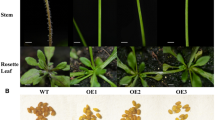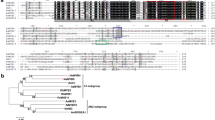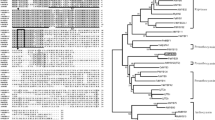Abstract
Anthocyanins are naturally occurring secondary metabolites, responsible for the color of many plants. The Arabidopsis thaliana MYB90/PAP2 (production of anthocyanin pigment 2) was introduced into tomato to study its effect on anthocyanin accumulation. The transgenic tomato displayed much greater anthocyanin accumulation than wild type in all plant organs, but the organs were not fully purple in color except for the stamen. The expression of anthocyanin biosynthetic genes and an anthocyanin-related basic helix-loop-helix (bHLH) gene SlAN1 was significantly increased in the transgenic line, suggesting that ectopic expression of AtPAP2 increases the expression of anthocyanin-related structural and regulatory genes to enhance anthocyanin content. Yeast two-hybrid assays revealed that the endogenous MYB protein SlAN2 interacted with two putative bHLH partners, SlAN1 and SlJAF13, while AtPAP2 only interacted with SlJAF13, which may be why AtPAP2 transgenic plants showed limited anthocyanin accumulation in fruits. In addition to anthocyanin accumulation, the transgenic tomato plants were significantly smaller in size, and the length of primary roots and number of lateral roots were obviously decreased. The expression of lignin biosynthetic genes was downregulated in transgenic tomato plants, which may be the reason for the inhibited growth. The lateral organ boundaries-domain (LBD) genes, which regulate lateral root organogenesis in the auxin signaling pathway, were downregulated in transgenic tomato roots, which may partly account for the disturbed lateral root formation in the transformants. Taken together, the results demonstrate that heterologous expression of transcription factor AtPAP2 not only resulted in anthocyanin accumulation but also inhibited plant growth in tomato.







Similar content being viewed by others
Change history
03 March 2018
In the original version of this article the “Acknowledgements” and the “Competing interests” were inadvertently omitted. The information missing in the original article is now given below.
References
Ahmed NU, Park JI, Jung HJ, Hur Y, Nou IS (2015) Anthocyanin biosynthesis for cold and freezing stress tolerance and desirable color in Brassica Rapa. Funct Integr Genomics 15(4):383–394. https://doi.org/10.1007/s10142-014-0427-7
Allan AC, Hellens RP, Laing WA (2008) MYB transcription factors that colour our fruit. Trends Plant Sci 13(3):99–102. https://doi.org/10.1016/j.tplants.2007.11.012
An JP, Qu FJ, Yao JF, Wang XN, You CX, Wang XF, Hao YJ (2017) The bZIP transcription factor MdHY5 regulates anthocyanin accumulation and nitrate assimilation in apple. Hortic Res 4:17023. https://doi.org/10.1038/hortres.2017.56
Azuma A, Kobayashi S, Mitani N, Shiraishi M, Yamada M, Ueno T, Kono A, Yakushiji H, Koshita Y (2008) Genomic and genetic analysis of Myb-related genes that regulate anthocyanin biosynthesis in grape berry skin. Anthocyanin biosynthesis in grape berry skin. Theor Appl Genet 117(6):1009–1019. https://doi.org/10.1007/s00122-008-0840-1
Ban Y, Honda C, Hatsuyama Y, Igarashi M, Bessho H, Moriguchi T (2007) Isolation and functional analysis of a MYB transcription factor gene that is a key regulator for the development of red coloration in apple skin. Plant Cell Physiol 48(7):958–970. https://doi.org/10.1093/pcp/pcm066
Bhargava A, Mansfield SD, Hall HC, Douglas CJ, Ellis BE (2010) MYB75 functions in regulation of secondary cell wall formation in the Arabidopsis inflorescence stem. Plant Physiol 154(3):1428–1438. https://doi.org/10.1104/pp.110.162735
Borevitz JO, Xia Y, Blount J, Dixon RA, Lamb C (2000) Activation tagging identifies a conserved MYB regulator of phenylpropanoid biosynthesis. Plant Cell 12(12):2383–2394. https://doi.org/10.1105/tpc.12.12.2383
Bovy A, de Vos R, Kemper M, Schijlen E, Almenar Pertejo M, Muir S, Collins G, Robinson S, Verhoeyen M, Hughes S, Santos-Buelga C, van Tunen A (2002) High-flavonol tomatoes resulting from the heterologous expression of the maize transcription factor genes LC and C1. Plant Cell 14(10):2509–2526. https://doi.org/10.1105/tpc.004218
Brunetti C, Di Ferdinando M, Fini A, Pollastri S, Tattini M (2013) Flavonoids as antioxidants and developmental regulators: relative significance in plants and humans. Int J Mol Sci 14:3540–3555
Butelli E, Titta L, Giorgio M, Mock HP, Matros A, Peterek S, Schijlen EGWM, Hall RD, Bovy AG, Luo J, Martin C (2008) Enrichment of tomato fruit with health-promoting anthocyanins by expression of select transcription factors. Nat Biotechnol 26(11):1301–1308. https://doi.org/10.1038/nbt.1506
Castaneda-Ovando A, de Lourdes P-HM, Elena Paez-Hernandez M, Rodriguez JA, Andres Galan-Vidal C (2009) Chemical studies of anthocyanins: a review. Food Chem 113(4):859–871. https://doi.org/10.1016/j.foodchem.2008.09.001
Dan YH, Yan H, Munyikwa T, Dong J, Zhang YL, Armstrong CL (2006) MicroTom-a high-throughput model transformation system for functional genomics. Plant Cell Rep 25(5):432–441. https://doi.org/10.1007/s00299-005-0084-3
De Smet I, Lau S, Voss U, Vanneste S, Benjamins R, Rademacher EH, Schlereth A, de Rybel B, Vassileva V, Grunewald W, Naudts M, Levesque MP, Ehrismann JS, Inze D, Luschnig C, Benfey PN, Weijers D, van Montagu MCE, Bennett MJ, Jurgens G, Beeckman T (2010) Bimodular auxin response controls organogenesis in Arabidopsis. P Natl Acad Sci USA 107(6):2705–2710. https://doi.org/10.1073/pnas.0915001107
Doodeman M, Boersma EA, Koomen W, Bianchi F (1984) Genetic analysis of instability in Petunia hybrida: 1. A highly unstable mutation induced by a transposable element inserted at the An1 locus for flower colour. Theor Appl Genet 67(4):345–355. https://doi.org/10.1007/BF00272873
Duan L, Ding W, Liu X, Cheng X, Cai J, Hua E, Jiang H (2017) Biosynthesis and engineering of kaempferol in Saccharomyces cerevisiae. Microb Cell Factories 16:165
Espley RV, Hellens RP, Putterill J, Stevenson DE, Kutty-Amma S, Allan AC (2007) Red colouration in apple fruit is due to the activity of the MYB transcription factor, MdMYB10. Plant J 49(3):414–427. https://doi.org/10.1111/j.1365-313X.2006.02964.x
Fang J (2015) Classification of fruits based on anthocyanin types and relevance to their health effects. Nutrition 31(11-12):1301–1306. https://doi.org/10.1016/j.nut.2015.04.015
Feng F, Li M, Ma F, Cheng L (2013) Phenylpropanoid metabolites and expression of key genes involved in anthocyanin biosynthesis in the shaded peel of apple fruit in response to sun exposure. Plant Physiol Biochem 69:54–61. https://doi.org/10.1016/j.plaphy.2013.04.020
Feng Z, Sun X, Wang G, Liu H, Zhu J (2012a) LBD29 regulates the cell cycle progression in response to auxin during lateral root formation in Arabidopsis thaliana. Ann Bot (Lond) 110:1–10
Feng Z, Zhu J, Du X, Cui X (2012b) Effects of three auxin-inducible LBD members on lateral root formation in Arabidopsis thaliana. Planta 236(4):1227–1237. https://doi.org/10.1007/s00425-012-1673-3
Franke R, Hemm MR, Denault JW, Ruegger MO, Humphreys JM, Chapple C (2002a) Changes in secondary metabolism and deposition of an unusual lignin in the ref8 mutant of Arabidopsis. Plant J 30(1):47–59. https://doi.org/10.1046/j.1365-313X.2002.01267.x
Franke R, Humphreys JM, Hemm MR, Denault JW, Ruegger MO, Cusumano JC, Chapple C (2002b) The Arabidopsis REF8 gene encodes the 3-hydroxylase of phenylpropanoid metabolism. Plant J 30(1):33–45. https://doi.org/10.1046/j.1365-313X.2002.01266.x
Friml J, Benkova E, Blilou I, Wisniewska J, Hamann T, Ljung K et al (2002) AtPIN4 mediates sink-driven auxin gradients and root patterning in Arabidopsis. Cell 108(5):661–673. https://doi.org/10.1016/S0092-8674(02)00656-6
Fukaki H, Tameda S, Masuda H, Tasaka M (2002) Lateral root formation is blocked by a gain-of-function mutation in the SOLITARY-ROOT/IAA14 gene of Arabidopsis. Plant J 29(2):153–168. https://doi.org/10.1046/j.0960-7412.2001.01201.x
Goh T, Joi S, Mimura T, Fukaki H (2012) The establishment of asymmetry in Arabidopsis lateral root founder cells is regulated by LBD16/ASL18 and related LBD/ASL proteins. Development 139(5):883–893. https://doi.org/10.1242/dev.071928
Gonzali S, Mazzucato A, Perata P (2009) Purple as a tomato: towards high anthocyanin tomatoes. Trends Plant Sci 14:237–241
Han Y, Vimolmangkang S, Soria-Guerra RE, Korban SS (2012) Introduction of apple ANR genes into tobacco inhibits expression of both CHI and DFR genes in flowers, leading to loss of anthocyanin. J Exp Bot 63(7):2437–2447. https://doi.org/10.1093/jxb/err415
He J, Giusti MM (2010) Anthocyanins: natural colorants with health-promoting properties. Annu Rev Food Sci Technol 1(1):163–187. https://doi.org/10.1146/annurev.food.080708.100754
Hichri I, Heppel SC, Pillet J, Leon C, Czemmel S, Delrot S et al (2010) The basic helix-loop-helix transcription factor MYC1 is involved in the regulation of the flavonoid biosynthesis pathway in grapevine. Mol Plant 3(3):509–523. https://doi.org/10.1093/mp/ssp118
Ilk N, Ding J, Ihnatowicz A, Koornneef M, Reymond M (2015) Natural variation for anthocyanin accumulation under high-light and low-temperature stress is attributable to the enhancer of AG-4 2 (HUA2) locus in combination with production of anthocyanin pigment1 (PAP1) and PAP2. New Phytol 206:422–435
Jaakola L (2013) New insights into the regulation of anthocyanin biosynthesis in fruits. Trends Plant Sci 18(9):477–483. https://doi.org/10.1016/j.tplants.2013.06.003
Kiferle C, Fantini E, Bassolino L, Povero G, Spelt C, Buti S, Giuliano G, Quattrocchio F, Koes R, Perata P, Gonzali S (2015) Tomato R2R3-MYB proteins SlANT1 and SlAN2: same protein activity, different roles. PLoS One 10(8):e0136365. https://doi.org/10.1371/journal.pone.0136365
Kong Q, Pattanaik S, Feller A, Werkman JR, Chai C, Wang Y, Grotewold E, Yuan L (2012) Regulatory switch enforced by basic helix-loop-helix and ACT-domain mediated dimerizations of the maize transcription factor R. P Natl Acad Sci USA 109(30):E2091–E2097. https://doi.org/10.1073/pnas.1205513109
Kovinich N, Kayanja G, Chanoca A, Riedl K, Otegui MS, Grotewold E (2014) Not all anthocyanins are born equal: distinct patterns induced by stress in Arabidopsis. Planta 240(5):931–940. https://doi.org/10.1007/s00425-014-2079-1
Lavenus J, Goh T, Roberts I, Guyomarc'h S, Lucas M, De Smet I et al (2013) Lateral root development in Arabidopsis: fifty shades of auxin. Trends Plant Sci 18(8):450–458. https://doi.org/10.1016/j.tplants.2013.04.006
Lee HW, Kim MJ, Kim NY, Lee SH, Kim J (2013) LBD18 acts as a transcriptional activator that directly binds to the EXPANSIN14 promoter in promoting lateral root emergence of Arabidopsis. Plant J 73(2):212–224. https://doi.org/10.1111/tpj.12013
Lee HW, Kim NY, Lee DJ, Kim J (2009) LBD18/ASL20 regulates lateral root formation in combination with LBD16/ASL18 downstream of ARF7 and ARF19 in Arabidopsis. Plant Physiol 151(3):1377–1389. https://doi.org/10.1104/pp.109.143685
Li X, Bonawitz ND, Weng JK, Chapple C (2010) The growth reduction associated with repressed lignin biosynthesis in Arabidopsis thaliana is independent of flavonoids. Plant Cell 22(5):1620–1632. https://doi.org/10.1105/tpc.110.074161
Li X, Weng JK, Chapple C (2008) Improvement of biomass through lignin modification. Plant J 54(4):569–581. https://doi.org/10.1111/j.1365-313X.2008.03457.x
Li Y, Kim JI, Pysh L, Chapple C (2015) Four isoforms of Arabidopsis 4-Coumarate:CoA ligase have overlapping yet distinct roles in phenylpropanoid metabolism. Plant Physiol 169(4):2409–2421. https://doi.org/10.1104/pp.15.00838
Liu J, Osbourn A, Ma P (2015) MYB transcription factors as regulators of phenylpropanoid metabolism in plants. Mol Plant 8:689–708
Liu Y, Lin-Wang K, Espley RV, Wang L, Yang H, Yu B, Dare A, Varkonyi-Gasic E, Wang J, Zhang J, Wang D, Allan AC (2016) Functional diversification of the potato R2R3 MYB anthocyanin activators AN1, MYBA1, and MYB113 and their interaction with basic helix-loop-helix cofactors. J Exp Bot 67(8):2159–2176. https://doi.org/10.1093/jxb/erw014
Livak KJ, Schmittgen TD (2001) Analysis of relative gene expression data using real-time quantitative PCR and the 2(−Delta Delta C(T)) method. Methods 25(4):402–408. https://doi.org/10.1006/meth.2001.1262
Majer C, Hochholdinger F (2011) Defining the boundaries: structure and function of LOB domain proteins. Trends Plant Sci 16(1):47–52. https://doi.org/10.1016/j.tplants.2010.09.009
Maloney GS, DiNapoli KT, Muday GK (2014) The anthocyanin reduced tomato mutant demonstrates the role of flavonols in tomato lateral root and root hair development. Plant Physiol 166(2):614–631. https://doi.org/10.1104/pp.114.240507
Matus JT, Aquea F, Arce-Johnson P (2008) Analysis of the grape MYB R2R3 subfamily reveals expanded wine quality-related clades and conserved gene structure organization across Vitis and Arabidopsis genomes. BMC Plant Biol 8:83
Mes PJ, Boches P, Myers JR, Durst R (2008) Characterization of tomatoes expressing anthocyanin in the fruit. J Am Soc Hortic Sci 133:262–269
Montefiori M, Brendolise C, Dare AP, Lin-Wang K, Davies KM, Hellens RP, Allan AC (2015) In the Solanaceae, a hierarchy of bHLHs confer distinct target specificity to the anthocyanin regulatory complex. J Exp Bot 66(5):1427–1436. https://doi.org/10.1093/jxb/eru494
Mouradov A, Spangenberg G (2014) Flavonoids: a metabolic network mediating plants adaptation to their real estate. Front Plant Sci 5:620. https://doi.org/10.3389/fpls.2014.00620
Murashige T, Skoog F (1962) A revised medium for rapid growth and bio assays with tobacco tissue cultures. Physiol Plantarum 15(3):473–497. https://doi.org/10.1111/j.1399-3054.1962.tb08052.x
Okushima Y, Fukaki H, Onoda M, Theologis A, Tasaka M (2007) ARF7 and ARF19 regulate lateral root formation via direct activation of LBD/ASL genes in Arabidopsis. Plant Cell 19:118–130
Outchkourov NS, Carollo CA, Gomez-Roldan V, de Vos RC, Bosch D, Hall RD, Beekwilder J (2014) Control of anthocyanin and non-flavonoid compounds by anthocyanin-regulating MYB and bHLH transcription factors in Nicotiana benthamiana leaves. Front Plant Sci 5:519. https://doi.org/10.3389/fpls.2014.00519
Overvoorde P, Fukaki H, Beeckman T (2010) Auxin control of root development. Cold Spring Harb Perspect Biol 2:a001537
Pan MH, Lai CS, Ho CT (2010) Anti-inflammatory activity of natural dietary flavonoids. Food Funct 1(1):15–31. https://doi.org/10.1039/c0fo00103a
Park S, Kim DH, Lee JY, Ha SH, Lim SH (2017) Comparative analysis of two flavonol synthases from different-colored onions provides insight into flavonoid biosynthesis. J Agr Food Chem 65(26):5287–5298. https://doi.org/10.1021/acs.jafc.7b01036
Peret B, De Rybel B, Casimiro I, Benkova E, Swarup R, Laplaze L et al (2009) Arabidopsis lateral root development: an emerging story. Trends Plant Sci 14(7):399–408. https://doi.org/10.1016/j.tplants.2009.05.002
Pojer E, Mattivi F, Johnson D, Stockley CS (2013) The case for anthocyanin consumption to promote human health: a review. Compr Rev Food Sci Food Saf 12(5):483–508. https://doi.org/10.1111/1541-4337.12024
Radicella JP, Brown D, Tolar LA, Chandler VL (1992) Allelic diversity of the maize B regulatory gene: different leader and promoter sequences of two B alleles determine distinct tissue specificities of anthocyanin production. Genes Dev 6(11):2152–2164. https://doi.org/10.1101/gad.6.11.2152
Schilmiller AL, Stout J, Weng JK, Humphreys J, Ruegger MO, Chapple C (2009) Mutations in the cinnamate 4-hydroxylase gene impact metabolism, growth and development in Arabidopsis. Plant J 60(5):771–782. https://doi.org/10.1111/j.1365-313X.2009.03996.x
Shen X, Zhao K, Liu L, Zhang K, Yuan H, Liao X, Wang Q, Guo X, Li F, Li T (2014) A role for PacMYBA in ABA-regulated anthocyanin biosynthesis in red-colored sweet cherry cv. Hong Deng (Prunus avium L.) Plant Cell Physiol 55(5):862–880. https://doi.org/10.1093/pcp/pcu013
Shi M-Z, Xie D-Y (2014) Biosynthesis and metabolic engineering of anthocyanins in Arabidopsis thaliana. Recent Pat Biotechnol 8(1):47–60. https://doi.org/10.2174/1872208307666131218123538
Shi Q-Q, Zhou L, Li K, Wang Y (2015) Transcriptional regulation involved in anthocyanin biosynthesis in plants. For Res 28:570–576 (In Chinese)
Shin DH, Cho M, Choi MG, Das PK, Lee SK, Choi SB, Park YI (2015) Identification of genes that may regulate the expression of the transcription factor production of anthocyanin pigment 1 (PAP1)/MYB75 involved in Arabidopsis anthocyanin biosynthesis. Plant Cell Rep 34(5):805–815. https://doi.org/10.1007/s00299-015-1743-7
Spelt C, Quattrocchio F, Mol J, Koes R (2002) ANTHOCYANIN1 of petunia controls pigment synthesis, vacuolar pH, and seed coat development by genetically distinct mechanisms. Plant Cell 14(9):2121–2135. https://doi.org/10.1105/tpc.003772
Spelt C, Quattrocchio F, Mol JN, Koes R (2000) anthocyanin1 of petunia encodes a basic helix-loop-helix protein that directly activates transcription of structural anthocyanin genes. Plant Cell 12(9):1619–1632. https://doi.org/10.1105/tpc.12.9.1619
Tang XG, Song KS, Liu DW, Wang ZM, Zhang B, Du J et al (2011) Comparison of methods for estimating soybean chlorophyll content based on visual/near infrared reflection spectra. Spectrosc Spect Anal 31:371–374 (In Chinese)
This P, Lacombe T, Cadle-Davidson M, Owens CL (2007) Wine grape (Vitis vinifera L.) color associates with allelic variation in the domestication gene VvmybA1. Theor Appl Genet 114(4):723–730. https://doi.org/10.1007/s00122-006-0472-2
Tohge T, de Souza LP, Fernie AR (2017) Current understanding of the pathways of flavonoid biosynthesis in model and crop plants. J Exp Bot 68(15):4013–4028. https://doi.org/10.1093/jxb/erx177
Tohge T, Nishiyama Y, Hirai MY, Yano M, Nakajima J, Awazuhara M et al (2005) Functional genomics by integrated analysis of metabolome and transcriptome of Arabidopsis plants over-expressing an MYB transcription factor. Plant J 42(2):218–235. https://doi.org/10.1111/j.1365-313X.2005.02371.x
Torres CA, Davies NM, Yanez JA, Andrews PK (2005) Disposition of selected flavonoids in fruit tissues of various tomato (lycopersicon esculentum mill.) genotypes. J Agr Food Chem 53(24):9536–9543. https://doi.org/10.1021/jf051176t
Toufektsian MC, de Lorgeril M, Nagy N, Salen P, Donati MB, Giordano L, Mock HP, Peterek S, Matros A, Petroni K, Pilu R, Rotilio D, Tonelli C, de Leiris J, Boucher F, Martin C (2008) Chronic dietary intake of plant-derived anthocyanins protects the rat heart against ischemia-reperfusion injury. J Nutr 138(4):747–752
Vu TT, Jeong CY, Nguyen HN, Lee D, Lee SA, Kim JH, Hong SW, Lee H (2015) Characterization of Brassica napus flavonol synthase involved in flavonol biosynthesis in Brassica napus L. J Agr Food Chem 63(35):7819–7829. https://doi.org/10.1021/acs.jafc.5b02994
Willits MG, Kramer CM, Prata RT, De Luca V, Potter BG, Steffens JC, Graser G (2005) Utilization of the genetic resources of wild species to create a nontransgenic high flavonoid tomato. J Agr Food Chem 53(4):1231–1236. https://doi.org/10.1021/jf049355i
Xie Q, Hu Z, Zhang Y, Tian S, Wang Z, Zhao Z, Yang Y, Chen G (2014) Accumulation and molecular regulation of anthocyanin in purple tumorous stem mustard (Brassica juncea var. tumida Tsen et Lee). J Agr Food Chem 62(31):7813–7821. https://doi.org/10.1021/jf501790a
Zhang L, Xu YS, Jia Y, Wang JY, Yuan Y, Yu Y, Tao JM (2016) Effect of floral cluster pruning on anthocyanin levels and anthocyanain-related gene expression in ‘Houman’ grape. Hortic Res 3:16037. https://doi.org/10.1038/hortres.2016.37
Zhao L, Gao L, Wang H, Chen X, Wang Y, Yang H, Wei C, Wan X, Xia T (2013) The R2R3-MYB, bHLH, WD40, and related transcription factors in flavonoid biosynthesis. Funct Integr Genomics 13:75–98
Zuluaga DL, Gonzali S, Loreti E, Pucciariello C, Degl'Innocenti E, Guidi L, Alpi A, Perata P (2008) Arabidopsis thaliana MYB75/PAP1 transcription factor induces anthocyanin production in transgenic tomato plants. Funct Plant Biol 35(7):606–618. https://doi.org/10.1071/FP08021
Author information
Authors and Affiliations
Corresponding authors
Rights and permissions
About this article
Cite this article
Li, N., Wu, H., Ding, Q. et al. The heterologous expression of Arabidopsis PAP2 induces anthocyanin accumulation and inhibits plant growth in tomato. Funct Integr Genomics 18, 341–353 (2018). https://doi.org/10.1007/s10142-018-0590-3
Received:
Revised:
Accepted:
Published:
Issue Date:
DOI: https://doi.org/10.1007/s10142-018-0590-3




